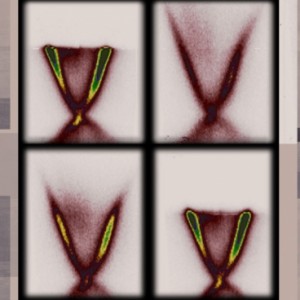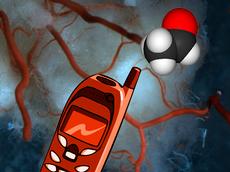Nano at a billionth (of a second, or a metre, or some other measure) is not the smallest unit of measurement, despite how we often talk about nano ‘anything’. But, as we continue to explore matter at ever more subtle levels, we need ever smaller units of measure and there are some ready for use.
I have a few excerpts from a Sept. 18, 2012 article (Explained: Femtoseconds and attoseconds) by David Chandler at the Massachusetts Institute of Technology (MIT) describing some of these smaller units of measure and how they were devised,
Back in the first half of the 20th century, when MIT’s famed Harold “Doc” Edgerton was perfecting his system for capturing fast-moving events on film, the ability to observe changes unfolding at a scale of microseconds — millionths of a second — was considered a remarkable achievement. This led to now-famous images such as one of a bullet piercing an apple, captured in midflight.
Nowadays, microsecond-resolution imagery is almost ho-hum. The cutting edge of research passed through nanoseconds (billionths of a second) and picoseconds (trillionths) in the 1970s and 1980s. Today, researchers can easily reach into the realm of femtoseconds — quadrillionths (or millionths of a billionth) of a second, the timescale of motions within molecules.
Femtosecond laser research led to the development, in 2000, of a system that revolutionized the measurement of optical frequencies and enabled optical clocks. Continuing the progress, today’s top-shelf technologies are beginning to make it possible to observe events that last less than 100 attoseconds, or quintillionths of a second.
Those prefixes — micro, nano, pico, femto and atto — are part of an internationally agreed-upon system called SI units (from the French Système International d’Unités, or International System of Units). The system was officially adopted in 1960, and has been updated periodically, most recently in 1991. It encompasses a total of 20 prefixes, 10 of them for decimal amounts, and 10 more for large multiples of the basic units (mega, giga, tera and so on).
As Chandler points out in more detail than I have, there’s a reason for developing these units of measure,
The ability to observe events on such timescales is important for basic physics — to understand how atoms move within molecules — as well as for engineering semiconductor devices, and for understanding basic biological processes at the molecular level.
But physicists and engineers are interested in pushing these limits ever further. To understand the movements of electrons, and eventually those of subatomic particles, requires attaining the attosecond and ultimately zeptosecond (sextillionths of a second) range, Kaertner says. Achieving that requires pushing technology to produce pulses using higher-wavelength sources, and also producing pulses that encompass a wider range of frequencies — a more broadband source.
I finally managed to conceptualize the nanoscale a few years ago but it appears I have more work to do. Chandler offers some suggestions for imagining the femtoscale,
So, just how short is a femtosecond? One way to think of it, Kaertner [Franz Kaertner, MIT adjunct professor of electrical engineering] says, is in terms of how far light can move in a given amount of time. Light travels about 300,000 kilometers (or 186,000 miles) in one second. That means it goes about 30 centimeters — about one foot — in one nanosecond. In one femtosecond, light travels just 300 nanometers — about the size of the biggest particle that can pass through a HEPA filter, and just slightly larger than the smallest bacteria.
Another way of thinking about the length of a femtosecond is this: One femtosecond is to one second as one second is to about 32 million years.
Chandler discuses in another MIT article (Watching electrons move at high speed) also posted on Sept. 18, 2012, a new electronic material, a topological insulator, and the importance of viewing the behaviour of electrons present in such an insulator,
Topological insulators are exotic materials, discovered just a few years ago, that hold great promise for new kinds of electronic devices. The unusual behavior of electrons within them has been very difficult to study, but new techniques developed by a team of researchers at MIT could help unlock the mysteries of exactly how electrons move and react in these materials, opening up new possibilities for harnessing them.
For the first time, the MIT team has managed to create three-dimensional “movies” of electron behavior in a topological insulator, or TI. [can be viewed here] The movies can capture vanishingly small increments of time — down to the level of a few femtoseconds, or millionths of a billionth of a second — so that they can catch the motions of electrons as they scatter in response to a very short pulse of light.
Electrons normally have mass, just like many other fundamental particles, but when moving along the surface of TIs they move as if they were massless, like light — one of the extraordinary characteristics that give these new materials such promise for new technologies. [emphases mine]
It’s the bit about mass and masslessness that caught my eye. Fascincating, non? Here’s a graphical representation of what the MIT scientists observed (I think it looks like a cup or a grail),

Three-dimensional graphical representations of the way electrons respond to an input of energy, delivered by a pulse of laser light. The horizontal axis represents the electrons’ momentum, and the vertical axis shows their energy. The time sequence runs from top left to bottom right, and the laser pulse arrives just before the second image, causing a sudden burst of higher energy levels. Images courtesy of Yihua Wang and Nuh Gedik [of MIT]
Here’s a bit more about TIs and possible future applications,
TIs are a class of materials with seemingly contradictory characteristics: The bulk of the material acts as an insulator, almost completely blocking any flow of electrons. But the surface of the material behaves as a very good conductor, like a metal, allowing electrons to travel freely. In fact, the surface is even more conductive than normal metals — allowing electrons to travel at almost the speed of light and to be unaffected by impurities in the material, which normally hinder their motion.
Because of these characteristics, TIs are seen as a promising new material for electronic circuits and data-storage devices. But developing such new devices requires a better understanding of exactly how electrons move around on and inside the TI, and how the surface electrons interact with those inside the material.
I highly recommend reading both of Chandler’s articles.

